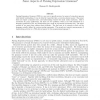555 search results - page 32 / 111 » Decompositions of Grammar Constraints |
EACL
1989
ACL Anthology
13 years 11 months ago
1989
ACL Anthology
This paper shows how higher levels of generalization can be introduced into unification grammars by exploiting methods for typing grammatical objects. We discuss the strategy of u...
ACL
2009
13 years 7 months ago
2009
Binarization of n-ary rules is critical for the efficiency of syntactic machine translation decoding. Because the target side of a rule will generally reorder the source side, it ...
CORR
2006
Springer
13 years 9 months ago
2006
Springer
Once the set of finite graphs is equipped with an algebra structure (arising from the definition of operations that generalize the concatenation of words), one can define the noti...
DAGSTUHL
2004
13 years 11 months ago
2004
One aim of tool integration is designing an integrated development environment that accesses the data/models of different tools and keeps them consistent throughout a project bein...
FUIN
2008
13 years 9 months ago
2008
Parsing Expression Grammar (PEG) is a new way to specify syntax, by means of a top-down process with limited backtracking. It can be directly transcribed into a recursive-descent ...

